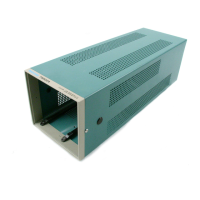Cleaning
3-2
Observe the following precautions to avoid damage:
1. Minimize handling of static-sensitive components.
2. Transport and store static-sensitive components or assemblies in their
original containers, on a metal rail, or on conductive foam. Label any
package that contains static-sensitive assemblies or components.
3. Discharge the static voltage from your body by wearing a wrist strap
while handling these components. Servicing static-sensitive assemblies
or components should be performed only at a static-free work station by
qualified service personnel.
4. Nothing capable of generating or holding a static charge should be
allowed on the work station surface.
5. Keep the component leads shorted together whenever possible.
6. Pick up components by the body, never by the leads.
7. Do not slide the components over any surface.
8. Avoid handling components in areas that have a floor or work surface
covering capable of generating a static charge.
9. Use a soldering iron that is connected to earth ground.
10. Use only special antistatic suction type or wick type desoldering tools.
This instrument should be cleaned as often as operating conditions require.
Loose dust accumulated on the outside of the instrument can be removed
with a soft cloth or small brush. Remove dirt that remains with a soft cloth
dampened in a mild detergent and water solution. Do not use abrasive
cleaners.
The best way to clean the interior is to blow off the accumulated dust with
dry, low-velocity air (approximately 5 lb/in
2
)
or use a soft brush or cloth
dampened with a mild detergent and water solution.
Circuit boards and components must be dry before applying power.
Avoid using chemical cleaning agents which can damage plastic
parts. Avoid chemicals containing benzene, toluene, zylene, ace-
tone, or similar solvents.
Maintenance
•
•
•
•
•
•
•
•
•
•
•
•
•
•
•
•
•
•
•
•
•
•
•
•
•
•
•
•
•
•
•
•

